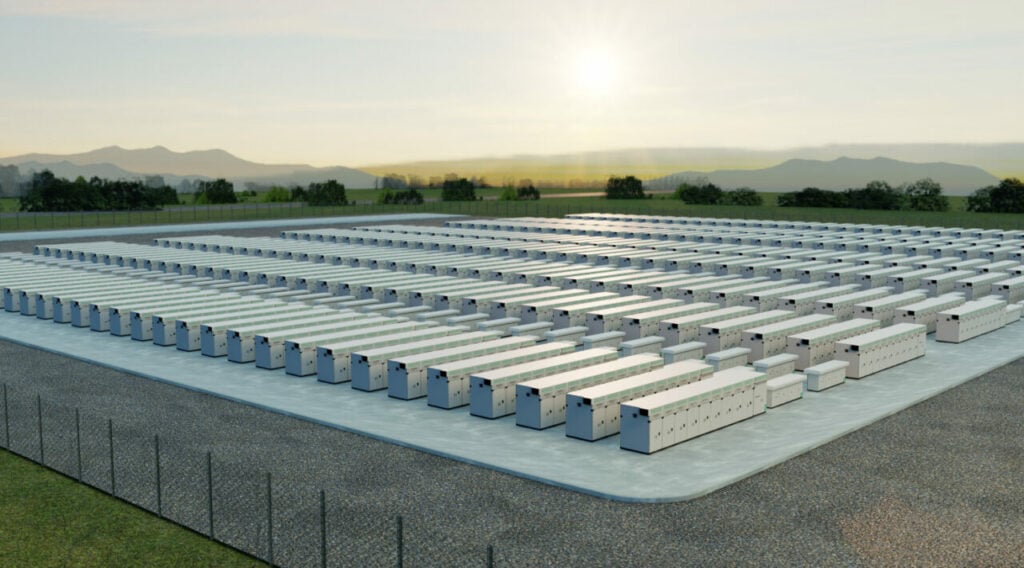
System integrator Powin is working on a new grid-scale BESS product to compete with increasingly competitive products from China, senior VP Danny Lu told us.
In an in-person interview, Lu also discussed other topics including the Waratah Super Battery project in Australia, fire safety and manufacturing strategy.
Enjoy 12 months of exclusive analysis
- Regular insight and analysis of the industry’s biggest developments
- In-depth interviews with the industry’s leading figures
- Annual digital subscription to the PV Tech Power journal
- Discounts on Solar Media’s portfolio of events, in-person and virtual
Lu said the new Powin Energy battery energy storage system (BESS) product would be a higher power and higher energy density alternative to its current Centipede modular grid-scale platform, in a response to a question about competing with China’s existing and emerging global BESS providers.
The emergence and growing market share of more providers from China has also, anecdotally, been described as the main factor behind a global fall in BESS prices from the highs of 2022. Many of those companies are launching products with a very high energy density, of between 4MWh and 5MWh per 20-foot shipping container-sized unit – in some cases helped by using in-house manufactured battery cells.
Centipede ‘has many advantages’ but energy density will increase
Speaking to Energy-Storage.news at the Energy Storage Summit EU in London last month, Lu said: “Our current Centipede platform has many advantages compared to competing products from China, but one area of opportunity for us is around increasing its energy density.”
“We are currently investing resources into engineering and partnerships to get a faster time to market for our next generation product – a more energy-dense and also higher-power product.”
“In specific markets where land is less abundant, like the UK, Europe and Southeast Asia, energy density is very important. This is less of an issue in other geographies like the US and Australia.”
“We also have the advantage of being a US company, with all our software designed in the US. The US and other markets have political barriers to software from China.”
On price, Lu said: “We’re aiming to be net-margin positive, which means we cannot take every deal. We are seeing certain suppliers losing money or making zero margin on projects just to take on market share and we don’t think that’s sustainable practice. Companies have tried and failed doing that.”
Using multiple battery suppliers for Waratah project
The conversation then moved on to a curiosity regarding Powin’s 850MW/1680MWh Waratah Super Battery project in Australia, the company’s largest to-date and potentially the world’s largest ‘single-phase’ BESS project in the world.
The two largest BESS online today – Moss Landing and Edwards Sanborn, both in California – are both larger overall but were built in multiple stages.
Powin publicly announced over the course of 2023 that it would integrate cells from two different suppliers into its Centipede BESS platform for the Waratah project: 280Ah lithium iron phosphate (LFP) cells from REPT and EVE Energy.
We asked Lu why the company has gone that route. He claimed that Powin is the first to utilise that multi-cell strategy for one product and project and that it made the company’s commercial offer for the project stronger, but also that it ‘de-risked’ the timelines of the project.
“We pitched that ability (to use different cells) to the customer, where we can offer the same performance, warranty, monitoring interface, and service process – that’s a compelling commercial offer,” Lu said.
“It’s more work for us that way, but it’s also a competitive advantage because when you are dependent on one supplier difficult situations can arise.”
“The offtaker for the Waratah project really bought into what we told them about leveraging these advantages to de-risk the timelines of the project. Based on that agreement, we all agreed that we needed to utilise two cell suppliers.”
Construction on Waratah, for developer Akaysha Energy, started in June 2023 for commercial operation in 2025.
Fire safety events
Last year also saw Powin in the headlines for the wrong reasons, with a Centipede BESS unit at one project catching fire and another ‘setting off a fire alarm’ and ‘experiencing problems’, both in New York State and owned by developer Convergent Energy + Power, which issued a statement in June noting that the manufacturer would be assessing what went wrong with one of its first field-deployed Centipedes.
The EPRI BESS Failure Event Database also lists a third fire event, based on local news reports, of a Powin BESS unit at an Idaho Power substation in October.
In a response to a question about what learnings Powin had gained from its recent fire safety events, Lu said: “We’ve come out of these experiences more knowledgeable about fire safety. We have learned even more about our product, its applications, and general processes to mitigate and manage fire safety situations.”
Manufacturing
The final topic we discussed during the interview touches on all of the above: bringing BESS manufacturing and assembly in-house versus using a third-party through contract manufacturing, the latter being the industry standard for most large system integrators.
Lu said that using contract manufacturing allowed it to scale up and down quickly while also having flexibility to evolve products.
“For the short and mid-term, we’ll still be contract manufacturing. The products are evolving so quickly, we want to depend on partners to support the ramp-up,” he said.
We also want to ensure we have flexible capacity so we can be called on when a mega project like Waratah comes around. And that is the case for the way we contract for both BESS manufacturing and cell capacity, resulting in greater manufacturing flexibility.”
The Oregon-headquartered company now has teams of 20 in both Australia and Europe (Madrid), having entered the European market at the start of 2024 with an order in Portugal from Galp and one in the UK from Pulse Clean Energy.
Energy-Storage.news’ publisher Solar Media will host the 5th Energy Storage Summit USA, 19-20 March 2024 in Austin, Texas. Featuring a packed programme of panels, presentations and fireside chats from industry leaders focusing on accelerating the market for energy storage across the country. For more information, go to the website.
Energy-Storage.news’ publisher Solar Media will host the 2nd Energy Storage Summit Asia, 9-10 July 2024 in Singapore. The event will help give clarity on this nascent, yet quickly growing market, bringing together a community of credible independent generators, policymakers, banks, funds, off-takers and technology providers. For more information, go to the website.






